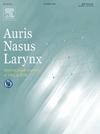Prevalence of sleep-disordered breathing in patients who underwent endoscopic nasal sinus surgery: investigation of nasal obstruction as a risk factor for sleep-disordered breathing
IF 1.5
4区 医学
Q2 OTORHINOLARYNGOLOGY
引用次数: 0
Abstract
Objective
To investigate the prevalence of sleep-disordered breathing (SDB) in patients with nasal diseases who underwent endoscopic nasal sinus surgery (ESS) compared with control patients without nasal disease who underwent tonsillectomy.
Methods
An observational retrospective case-control study was conducted of 150 adults with nasal diseases who underwent ESS (ESS group) as well as 94 adults with no nasal symptoms or diseases who underwent tonsillectomy due to infection of the tonsils (tonsillectomy group). Patients with obstructive sleep apnea, patients with a chief complaint of snoring or excessive daytime sleepiness, or patients having large tonsils were excluded from the study. Home sleep apnea testing was performed prior to admission for surgery.
Results
The prevalence in normal, mild, moderate, and severe SDB was respectively 30.0 %, 38.0 %, 22.7 %, and 9.3 % in the ESS group and 50.0 %, 39.4 %, 10.6 %, and 0 % in the tonsillectomy group. There were significant differences in the mean 3 % oxygen desaturation index (3 %ODI) score between the ESS and tonsillectomy groups in men but not in women. Obese men in the ESS group were much more susceptible to having moderate or severe SDB when they were aged ≥40 years. Regression analysis revealed that the preoperative 3 %ODI score had two significant determinants in the ESS group—BMI and male sex—whereas age, nasal resistance, and CRS with nasal polyps were not significant predictors.
Conclusions
Among patients who underwent ESS, 32.0 % had moderate to severe SDB, including 9.3 % with severe SDB. Nasal obstruction could be a potential risk factor for SDB in male patients.
鼻窦内窥镜手术患者睡眠呼吸障碍的患病率:鼻塞作为睡眠呼吸障碍危险因素的调查
目的探讨鼻部疾病患者行内窥镜鼻窦手术(ESS)后睡眠呼吸障碍(SDB)的发生率,并与对照组行扁桃体切除术的非鼻部疾病患者进行比较。方法采用观察性回顾性病例对照研究,对150例患有鼻部疾病的成人行ESS (ESS组)和94例无鼻部症状或疾病的成人因扁桃体感染行扁桃体切除术(扁桃体切除术组)进行研究。患有阻塞性睡眠呼吸暂停的患者、以打鼾或白天嗜睡为主诉的患者或扁桃体较大的患者被排除在研究之外。手术入院前进行家庭睡眠呼吸暂停测试。结果ESS组正常、轻度、中度、重度SDB患病率分别为30.0%、38.0%、22.7%、9.3%,扁桃体切除术组为50.0%、39.4%、10.6%、0%。在男性ESS组和扁桃体切除术组之间,平均3%氧去饱和指数(3% ODI)评分有显著差异,但在女性中无显著差异。ESS组肥胖男性在年龄≥40岁时更容易发生中度或重度SDB。回归分析显示,术前3% ODI评分在ESS组中有两个显著的决定因素——bmi和男性——而年龄、鼻阻力和伴有鼻息肉的CRS不是显著的预测因素。结论在接受ESS治疗的患者中,32.0%患有中重度SDB,其中重度SDB占9.3%。鼻塞可能是男性患者SDB的潜在危险因素。
本文章由计算机程序翻译,如有差异,请以英文原文为准。
求助全文
约1分钟内获得全文
求助全文
来源期刊

Auris Nasus Larynx
医学-耳鼻喉科学
CiteScore
3.40
自引率
5.90%
发文量
169
审稿时长
30 days
期刊介绍:
The international journal Auris Nasus Larynx provides the opportunity for rapid, carefully reviewed publications concerning the fundamental and clinical aspects of otorhinolaryngology and related fields. This includes otology, neurotology, bronchoesophagology, laryngology, rhinology, allergology, head and neck medicine and oncologic surgery, maxillofacial and plastic surgery, audiology, speech science.
Original papers, short communications and original case reports can be submitted. Reviews on recent developments are invited regularly and Letters to the Editor commenting on papers or any aspect of Auris Nasus Larynx are welcomed.
Founded in 1973 and previously published by the Society for Promotion of International Otorhinolaryngology, the journal is now the official English-language journal of the Oto-Rhino-Laryngological Society of Japan, Inc. The aim of its new international Editorial Board is to make Auris Nasus Larynx an international forum for high quality research and clinical sciences.
 求助内容:
求助内容: 应助结果提醒方式:
应助结果提醒方式:


